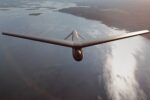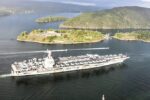Sweden is taking a significant step toward integrating uncrewed maritime systems by launching a procurement effort for a dedicated test and experimentation ship. The initiative, led by the Swedish Defence Materiel Administration (FMV), aims to establish a flexible platform for rapid prototyping and operational evaluation of uncrewed surface vessels (USVs), uncrewed underwater vehicles (UUVs), and their supporting C2 infrastructure. This move aligns with broader NATO and Nordic defense trends emphasizing autonomy and distributed maritime operations.
FMV Launches Procurement for Uncrewed Systems Test Platform
At DSEI 2025 in London, Sweden’s FMV announced its intent to acquire or lease a vessel specifically adapted for testing naval uncrewed systems. The platform will support experimentation with both surface and subsurface autonomous vehicles while enabling integration with C2 networks and manned platforms.
The vessel is expected to be operational by 2026 and will serve as a modular testbed rather than a combatant. It will be operated by the Royal Swedish Navy in close cooperation with FMV’s test & evaluation units. According to FMV officials speaking at DSEI, the project is part of Sweden’s broader push toward “system-of-systems” integration in naval warfare—linking sensors, effectors, and platforms across domains.
Key requirements for the ship include:
- Deck space and launch/recovery systems for multiple classes of USVs/UUVs
- Modular mission bays for sensor/cargo payloads
- C4ISR suites compatible with Link-16/NATO STANAG protocols
- Facilities for onboard data processing and remote control
A Strategic Pivot Toward Maritime Autonomy
This initiative reflects Sweden’s growing recognition of the strategic value of autonomous maritime capabilities in Baltic Sea operations. With increasing Russian naval activity in the region—including undersea infrastructure threats—NATO-aligned nations are accelerating investments in ISR-capable UUVs and mine countermeasure (MCM) USVs.
Sweden has already trialed several indigenous platforms such as Saab’s AUV62-AT autonomous underwater system and participated in NATO exercises involving collaborative autonomous MCM operations. However, until now there has been no dedicated national platform for sustained system-level testing at sea.
The new ship will fill that gap—serving not only as an R&D enabler but also as an operational bridge between lab-proven prototypes and mission-ready assets.
Industry Implications: Saab Likely to Play Central Role
The Swedish defense industry—particularly Saab—is expected to play a key role in supplying both the uncrewed vehicles tested aboard the new vessel and potentially its onboard systems architecture. Saab already provides several relevant platforms:
- AUV62-AT: Autonomous target vehicle used for ASW training
- MULE UUV: Modular UUV designed for ISR/MCM roles
- Sea Wasp ROV: Lightweight remotely operated vehicle used in EOD scenarios
The company also supplies integrated combat management systems (CMS) such as 9LV that could be adapted into C4ISR suites aboard the test ship.
If Saab is selected as lead integrator or prime contractor—a likely outcome given its track record—it would further solidify its position as Sweden’s dominant player in naval autonomy. However, FMV has indicated it may open parts of the program to international competition or collaboration under EU/NATO frameworks like EDIDP or DIANA.
C4ISR Integration Will Be Central Challenge
While hardware trials are essential, FMV emphasized that one of the core goals is validating how uncrewed assets can be integrated into Sweden’s existing command-and-control architecture. This includes real-time data fusion from distributed sensors (EO/IR/Sonar), secure communications over SATCOM or tactical datalinks like Link-16/BLOS relay nodes, and AI-assisted decision support tools.
The planned ship will host onboard processing nodes capable of ingesting sensor feeds from multiple vehicles simultaneously—enabling live mission rehearsal or red-teaming exercises under realistic conditions. Additionally, it may serve as a node within larger NATO exercises such as BALTOPS or Dynamic Messenger where interoperability with allied navies’ unmanned assets can be validated.
Toward Operational Deployment by Late Decade
If timelines hold—and funding remains stable—the new testbed could begin sea trials by late 2026. Lessons learned from these trials will feed directly into future procurement decisions on deployable USVs/UUVs across missions including MCM, ASW screening, harbor defense, seabed surveillance, EW payload delivery, or even loitering munitions delivery via surface drones.
This approach mirrors similar efforts underway across Europe:
- The UK Royal Navy’s NavyX program using XV Patrick Blackett as an experimental vessel
- NORWAY’s use of HNoMS Olav Tryggvason for MCM drone trials under SNMCMG1 rotation
- The Netherlands’ DARE initiative focused on modular unmanned experimentation afloat
Conclusion: A Pragmatic Step Toward Maritime Autonomy at Scale
Rather than rushing into full-scale acquisition of unproven autonomous platforms, Sweden is opting for an incremental yet agile approach—building institutional knowledge through hands-on experimentation aboard a dedicated ship. This strategy not only reduces technical risk but also ensures that future acquisitions are tightly aligned with real-world operational needs in Baltic littoral conditions.
If successful, this program could position Sweden among Europe’s leaders in naval autonomy—not just through technology development but through doctrine-informed integration at fleet level.









